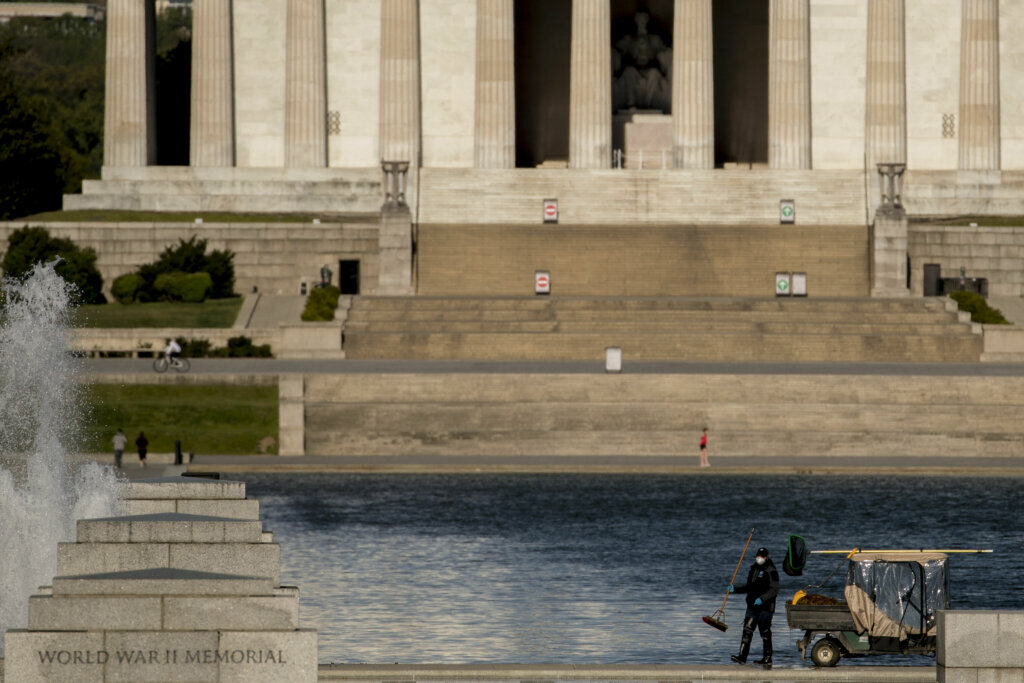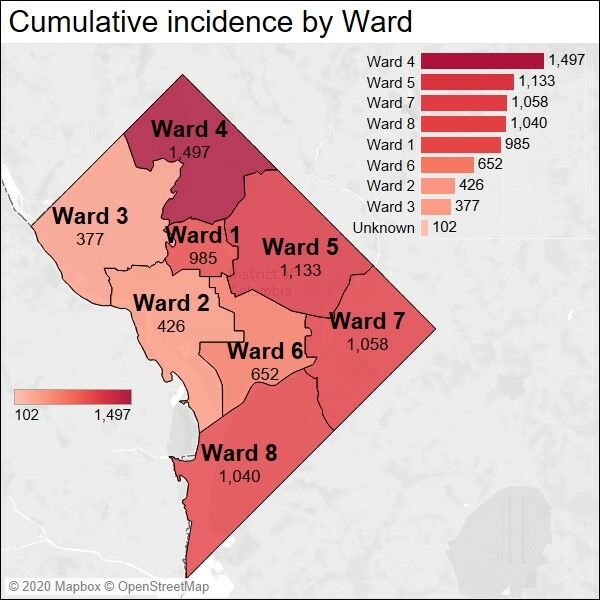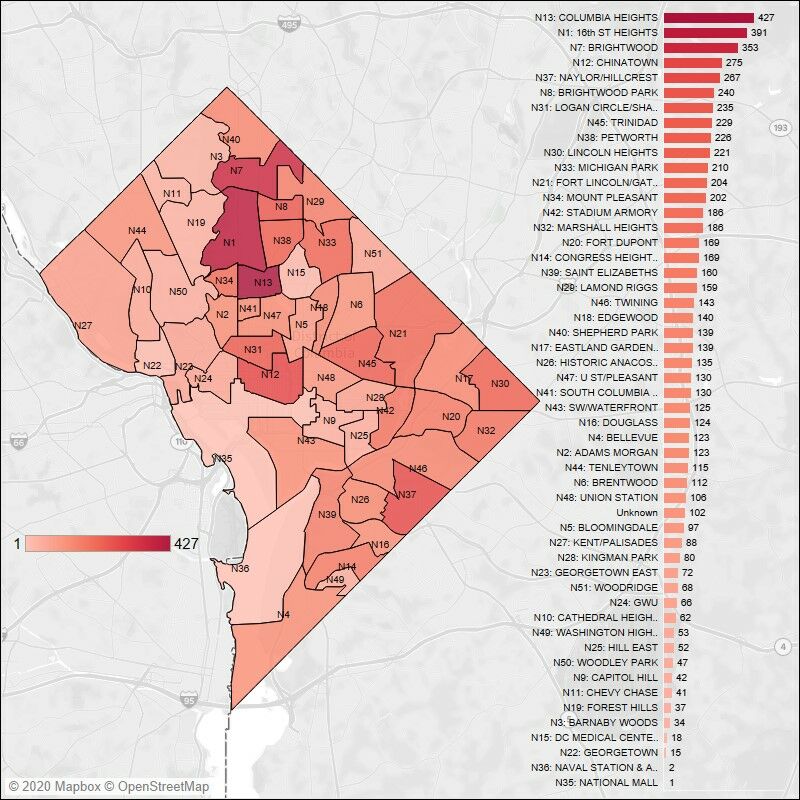
Bowser’s budget cuts; coronavirus response
D.C. Mayor Muriel Bowser released her proposed fiscal year 2021 budget during a news conference Monday.
The mayor and City Administrator Rashad Young outlined the details of the budget, which includes $166 million in reductions to agency budgets, such as cutting all pay increases.
“I want to thank everybody for the sacrifices and hard work that they put into this,” Bowser said. “We know that in addition to the public health emergency, the pandemic has quickly created a second emergency. And that’s a national economic crisis.”
The D.C. Police Union said that the exclusion raises from the amended budget is only the mayor’s position, and there are still a “number of procedural steps that the budget must go though, including approval in the D.C. Council.”
The union said in a news release that it will continue to express its concerns about compensation for officers. “The Union remains undeterred and plans to continue along the current path of negotiating a new contract through the collective bargaining process.”
In all, Bowser said D.C. has lost more than $720 million in expected revenue. The District also anticipates a revenue shortfall of $774 million for 2021.
- Sign up for news alerts from WTOP
- Travel in the ‘new normal’: When coronavirus restrictions loosen, what will travel be like?
- Coronavirus test results in DC, Maryland and Virginia
- Coronavirus timeline
- Where to get tested for COVID-19
- Coronavirus FAQ: What you need to know
- Coronavirus resources: Get and give help in DC, Maryland and Virginia
“On top of those losses, we have nearly spent $200 million of our funds in response and recovery. And those costs will continue to grow by the hundreds of millions of dollars in the coming weeks and months,” Bowser said.
“And just as this pandemic has forced our residents and businesses to make very difficult spending decisions, D.C. government has had to do the same thing. But I want to be clear. While this is not the budget that I expected to send to the council earlier this year, it is a budget that I am proud of and that the city can be proud of.”
She added that she believes the 2021 budget is a reflection of the District’s priorities. That includes “significant” investments in schools, housing and health care.
Bowser’s office identified several areas to help close the immense budget gap:
- Full use of FY19 surplus — $322 million
- Full use of Fiscal Stabilization Reserve — $213 million
- Additional Revenue from Ballpark Stadium Bond Defeasance — $105 million
- Utilized estimated bond refinancing savings in FY21 and FY22 — $80 million
- Assumed no pay growth in the out-years of the plan — $250 million
Additionally, D.C. businesses and residents are estimated to receive $3.9 billion in federal response and recovery funds.
Young went into greater detail on the budget, noting that D.C. is drawing on multiple reserves to stabilize the budget.
“We use the cash flows — or the CFO (chief financial officer) uses the cash flow reserve — to pay the bills and expenses for the District on an ongoing basis while we wait to receive cash at various points of time in the year, and so this reserve is really how we manage our liquidity,” Young said.
Other reserves include contingency cash ($299 million, of which $236.4 million has mostly been used for D.C.’s COVID-19 response) and the fiscal stabilization reserve ($213 million).
Young said a fourth reserve is also available: the emergency reserve, “which is for extraordinary unanticipated and nonrecurring needs.”
The District has not used the emergency reserve and, according to Young, D.C. does not “anticipate using that reserve because we’re using so much of the other three.”
Young added that D.C. does expect to use more funds on its response to a possible second wave of coronavirus cases.
Bowser will present her budget to the D.C. Council on Tuesday.
See the details online at the Office of the Chief Financial Officer.
DC Council to vote on emergency bill Tuesday
D.C. Council Chairman Phil Mendelson said the council will vote on an emergency bill Tuesday.
He called it a “consolidation” of previous bills that aims to address the impact of the coronavirus crisis on the District.
“The legislation tomorrow, as I said, is a consolidation and some refinement of what we’ve already adopted, but also, we’ll have some new provisions, such as requiring payment plans for utility customers who have been impacted by the economic situation around the emergency,” he said.
There are also proposals to help with business and economic development, such as the microgrant program the council authorized in March, consumer protection and regulation, and housing and tenant protections, according to Mendelson.
“Just to give you a sense of what the council has been considering since the beginning of this pandemic, or the emergency, is revisions to our labor laws, particularly with regard to unemployment insurance, and there are no new changes for tomorrow,” Mendelson said.
Mortgage deferrals, debt collection, credit reporting, panel rental payment plans — both for residential and commercial limitations on foreclosures — will also be addressed.
DC nearing target to begin Phase One of reopening
D.C. is potentially just six days from reaching a target needed to begin Phase One reopening.
For the first time since tracking began, Bowser said D.C. has gone eight straight days with a reduction in community spread.
City officials want 14 straight days of lower numbers before they consider reopening.
To reopen, D.C. needs to meet benchmarks on community spread, hospital capacity, testing capacity and the rate of transmission.
The mayor said she would speak later this week on Thursday about a possible phased reopening, barring “any unforeseen spike” in illnesses.
Latest DC coronavirus cases, deaths
The District reported 147 new positive coronavirus cases Monday, bringing the total to 7,270.
In addition, there were nine new deaths, for a total of 392.
Columbia Heights (427), 16th Street Heights (391) and Brightwood (353) continue to be hot spots. Black/African-American residents still constitute the hardest hit demographic, with 47% of coronavirus cases.
The following maps are a breakdown of cases by ward and neighborhood.


WTOP’s Alicia Abelson contributed to this report.








